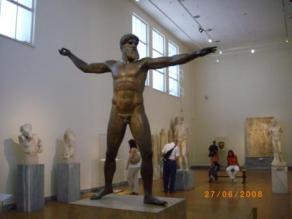Zeus and his Siblings: An Introduction
 We hear so much about Zeus and the Olympic Gods but who were they? It worries me sometimes when an archaeology student doesn’t know the basics so let’s begin! Hesiod explains that Zeus’s parents were Cronus and Rhea and his siblings included Hades, Poseidon, Hera, Hestia and Demeter. Hesiod accounts that Zeus fathered seven lesser gods, but only two of these were with his wife/sister’s Hera.1 These children were Ares and Hephaestos, Athene, Artemis and Apollo, Hermes and Aphrodite. 2 Though accounts made by Hesiod are generally agreed on by Homer, Homer’s works do indicate that he believed that all gods originated from the Ocean. Gantz explains that Homer implicates that Oceanos and Tethys were the actual parents of Zeus. 3
We hear so much about Zeus and the Olympic Gods but who were they? It worries me sometimes when an archaeology student doesn’t know the basics so let’s begin! Hesiod explains that Zeus’s parents were Cronus and Rhea and his siblings included Hades, Poseidon, Hera, Hestia and Demeter. Hesiod accounts that Zeus fathered seven lesser gods, but only two of these were with his wife/sister’s Hera.1 These children were Ares and Hephaestos, Athene, Artemis and Apollo, Hermes and Aphrodite. 2 Though accounts made by Hesiod are generally agreed on by Homer, Homer’s works do indicate that he believed that all gods originated from the Ocean. Gantz explains that Homer implicates that Oceanos and Tethys were the actual parents of Zeus. 3
Platzner and Harris explain that Zeus and his offspring did represent aspects of human beings so were anthropomorphic. Zeus represents the complexity of human sexuality/lust.4 Grimal also links Zeus to mortals with the idea of being subject to fate. Zeus’s offspring can also be seen as displaying anthropomorphic qualities. Aphrodite was the goddess of love, love being at the heart of all humans and something that all desire.5 All the gods maintained human characteristics, such as Artemis’ wildness and anger, and Athene’s strength and warrior like qualities.6 Though these gods represent the world around us such as the ocean and earth, they also include human characteristics which govern their actions. So to a fair extent, Zeus and his offspring are anthropomorphic deities.
Kerenyi assesses that Zeus’s main attributes and Functions include his place as a supreme being, as father of the gods. 7 Zeus’s defeat of the Titans illustrates military prowess, strength and he is seen as a divine warrior. 8 Platzner and Harris assert that Zeus is a representation of the complexity of human sexuality in his lust, saying that “modern mythologists tallied no fewer than 115 different objects of Zeus’s affections”. 9 Zeus also was the “distributor of good and evil” 10, meaning that he has the function of maintaining the balance of the universe. He is also attributed to being the divine patron of the Olympic Games.
The older Olympian gods are still seen as creator gods and are generally related to universal ideas. They are more firmly intertwined with the universe as a whole and have greater and broader areas of influence. For instance, Hesiod describes Zeus as maintainer of balance in the universe, as the overseer of all that is good and evil. 11 Hera retains the creative power of her parents, an attribute which controls life itself. Poseidon is seen as the king of the sea, the ocean being a powerful force of nature. The younger Olympian god’s attributes are more specific. An assessment of Homer and Hesiod’s works suggest that these gods were more linked to certain aspects of humanity. 12 For instance, Artemis as the goddess of midwifery and childbirth and Apollo being the communicator of the God’s will to humanity. 13
The nature myth theory acts as an explanation for the creation of life as the ancient Greeks knew it. An assessment of this theory suggests that the functions of the Greek Pantheon were an extension of this explanation, further creating reason behind aspects of life by providing personifications of the world and of human characteristics. The theory explains the attributes and functions of the Pantheon to a great extent as it is the base from which the ideas of life and creation emerge which are reflected in the Pantheon’s traits.
- Hesiod, Theogony and Works and Days , Hesiod; West, M. L. , (1988)
- Harris, S.L. and Platzner, G., Classical Mythology, Images and Insights, Fourth Edition, (California, 2004), p. 178
- Gantz, T., “The Olympians” in Early Greek Myth: A Guide to Literary and Artistic Sources (London, 1993)
- Harris, S.L. and Platzner, G., op.cit., p.182
- Grimal, P., Dictionary of Classical Mythology (London, 1991), p. 47
- ibid., p.60, 66
- Kerenyi, C. (1997), The Gods Of The Greeks (London, 1961), p. 91
- Hesiod, op.cit., Book 1
- Harris, S.L. and Platzner, G., op.cit., p.182
- Grimal, P., op.cit., p. 454
- Hesiod, op.cit, Book 1
- Homer, Iliad, (Translated by A.T. Murray, 1924)
- Harris, S.L. and Platzner, G., op.cit., 194
Bibliography
Gantz, T., “The Olympians” in Early Greek Myth: A Guide to Literary and Artistic Sources (London, 1993), pp. 57-119 .
Grimal, P., Dictionary of Classical Mythology (London, 1991), pp. 47, 60, 66, 453-456
Harris, S.L. and Platzner, G., Classical Mythology, Images and Insights, Fourth Edition, (California, 2004), p. 178, pp.177-198
Hesiod, Theogony and Works and Days , Hesiod; West, M. L. , (1988)
Homer, Iliad, (Translated by A.T. Murray, 1924), Book 1
Homer, Odyssey (translated by A.T.Murray, 1919)
Kerenyi, C. (1997), The Gods Of The Greeks (London, 1961) , pp. 91-116
Kirk, G. S., The Nature of Greek Myths (London, 1988), pp. 113-145
Pinsent, J. (1969), Myths and Legend Of Ancient Greece (London), pp. 148-152

March 28, 2014 at 5:32 am
You can never take anything for granted where knowledge is concerned! Better to repeat a known thing (someone has always got it skew) than presume, and lose students.
March 28, 2014 at 5:33 am
I quite agree. Let the learning of all continue!